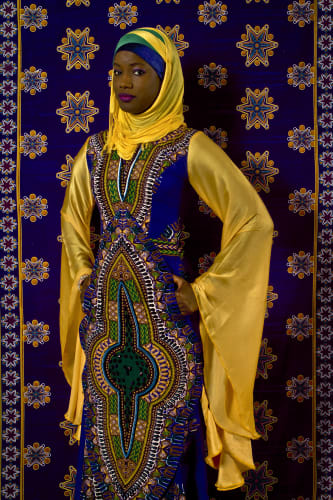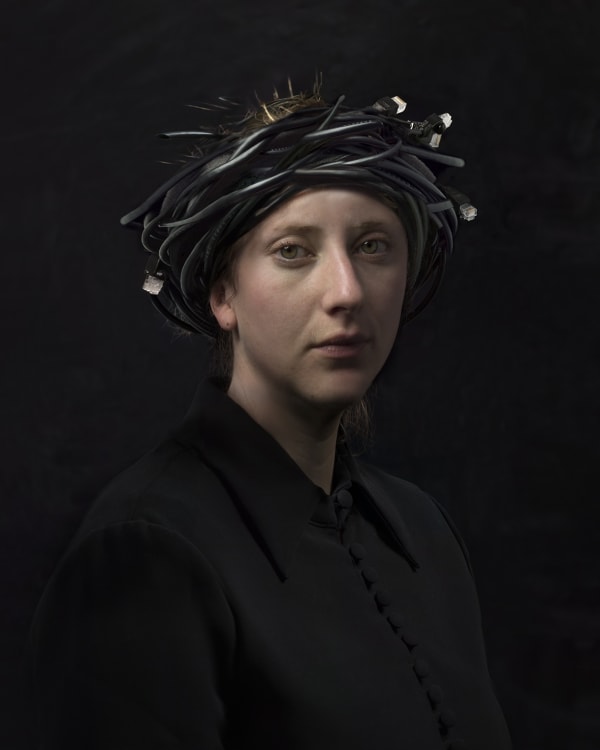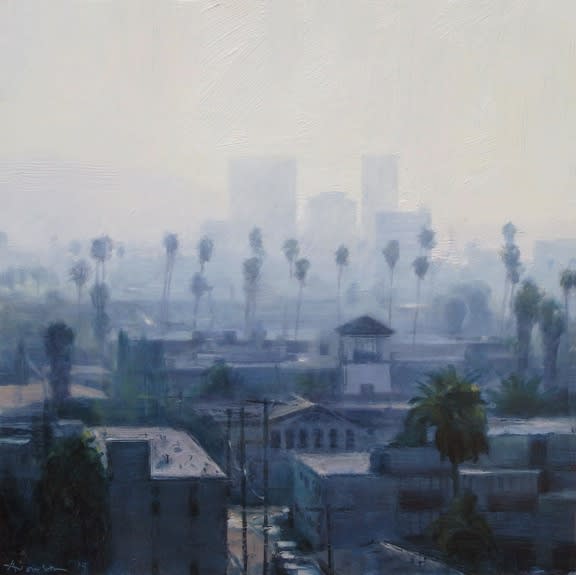In celebration of Women’s History Month, Jenkins Johnson Gallery is pleased to announce Spring Selections, an exhibition of contemporary works by international artists contributing to the advancement of women's rights. Featuring works by Lalla Essaydi, Aida Muluneh, Nnenna Okore, Julia Fullerton-Batten, Wesaam Al-Badry, Blessing Ngobeni, Omar Victor Diop, Gordon Parks, Hendrik Kerstens, and Julian Opie, Spring Selections presents a dialogue on female injustices and the ways in which women mobilize resistance in the Middle East, South Africa, United Kingdom, and United States. With this exhibition, Jenkins Johnson Gallery joins in the commemoration and continued development of women’s rights with public institutions including the National Gallery of Art, Smithsonian Institution, National Endowment for the Humanities and more. Additional contemporary works by Ben Aronson and Scott Fraser will also be displayed as previews for Aronson’s and Fraser’s upcoming solo exhibitions occurring later this year.
In celebration of Women’s History Month, Jenkins Johnson Gallery is pleased to announce Spring Selections, an exhibition of contemporary works by international artists contributing to the advancement of women's rights. Featuring works by Lalla Essaydi, Aida Muluneh, Nnenna Okore, Julia Fullerton-Batten, Wesaam Al-Badry, Blessing Ngobeni, Omar Victor Diop, Gordon Parks, Hendrik Kerstens, and Julian Opie, Spring Selections presents a dialogue on female injustices and the ways in which women mobilize resistance in the Middle East, South Africa, United Kingdom, and United States. With this exhibition, Jenkins Johnson Gallery joins in the commemoration and continued development of women’s rights with public institutions including the National Gallery of Art, Smithsonian Institution, National Endowment for the Humanities and more. Additional contemporary works by Ben Aronson and Scott Fraser will also be displayed as previews for Aronson’s and Fraser’s upcoming solo exhibitions occurring later this year.
Despite hailing from different countries in the Middle East and North Africa region, Lalla Essaydi (b.1956, Marrakesh, Morocco) and Wesaam Al-Badry (b.1984, Nasiriyah, Iraq) both use photography to examine Western perceptions of Arab women. In her large-scale photographs that conjure up the reclining odalisques of nineteenth-century Orientalist paintings, Essaydi empowers her figures with defiant gazes that resist voyeurism and stereotypes of exoticism. By incorporating her own insights into cross-cultural identity politics, Essaydi reclaims the imagery of harem scenes. Essaydi is simultaneously presenting in a solo exhibition at Lafayette College, PA until April 8, and at the Art Museum of Dickinson College, PA until May 12. Al-Badry similarly felt a strong disconnect between his lived experiences as a refugee from Iraq, and his new reality in Nebraska following his relocation. Now pursing his BFA in Photography at the San Francisco Art Institute, Al-Badry examines Western consumerism’s influence on traditional Muslim Culture in his newest series, Al Kouture, and reveals the tension between Occidental and Arab-Islamic ideologies. By tailoring and repurposing couture silk scarves into niqabs, Al-Badry investigates female objectification at the intersections of both male and market desires. Following Gucci’s AW18 Milan Fashion Week show, the brand has faced criticisms for accessorizing white models with hijabs and Sikh turbans under the overarching theme of dystopian abnormality. Conceptualized and created prior to Gucci’s show, Al-Badry’s portraits explore the commodification of traditional Muslim garb as a symbol of modernity, and the possibilities of assimilation in a vast and polarized world.
Spring Selections’ international perspective offers further insight into the thriving arts and cultural scenes in Senegal and Ethiopia, and the inspiring women at the center of these movements. Through portraits that emphasize his subject’s personality and cultural attributes, self-taught photographer Omar Victor Diop (b.1980, Dakar, Senegal) displays the diversity of modern African societies. In his series The Studio of Vanities, he captures the young entrepreneurs, fashion designers, visual artists, and models responsible for Dakar, Senegal’s urban culture. In the same spirit of social consciousness, Aida Muluneh (b.1974, Ethiopia) and her series The World is 9 focuses on body painting, inspired by traditional body art from across Africa. Her works express the history and future of Ethiopia, the power struggle for the women who live there, and personal references regarding life and love. Her latest body of work, Memory of Hope, confronts the viewer with photographs of critically relevant social commentary. She declares that people globally cannot afford to be politically passive or base their convictions on false faith, but rather question “hope” and provoke for the future that they desire. Muluneh is concurrently exhibiting in the MoMa exhibition Being: New Photography until August 19, and at Purdue University, IN, until March 31.
Speaking to the long march of advancement toward political equity for women of color, the presence of works by Gordon Parks (b.1912, Fort Scott, Kansas) and Blessing Ngobeni (b.1985, Tzaneen, South Africa), contribute an activist-oriented perspective to Spring Selections. In the wake of the 1955 bus boycott in Montgomery, Gordon Parks, Life Magazine’s first African-American staff photographer, captured the moment young Ondria Tanner peered into the display window of a white clothing store. As her grandmother steers her away from the collection of white mannequins, this photograph, included in the exhibition, demonstrates that resistance takes shape in the form of quiet individual actions in addition to bold demonstrations. In the face of such immense obstacles, Ngobeni’s large-scale mixed media paintings target the post-Apartheid South African government and its failures to deliver on promises of a more equal society. With abstracted female figures at the forefront of protests, Ngobeni offers a vision of post-colonial South Africa that is staggeringly complex, with a renewed focus on institutional racism.
Also prominently featured in Spring Selections are the works of Nnenna Okore (b.1975, Australia), Julia Fullerton-Batten (b.1970, Bremen, Germany), Hendrik Kerstens (b.1956, The Hague, Netherlands), and Julian Opie (b.1958, London, United Kingdom). While Okore’s environmentally conscious large-scale wall-sculptures expand the societally imposed classifications of black female art to limitless possibilities, Fullerton-Batten and Kerstens meditate on the transition from adolescence to womanhood and the paternal need to capture the fleeting essence of childhood respectively. Like Kerstens, Opie references the poses of Old Masters portraits to further elevate the status of his contemporary female subjects.
-

Omar Victor Diop
Oumy Ndour, 2012
ink-jet print on Harman by Hahnemuhle paper
35 7/16 x 23 5/8 in.
-

Aida Muluneh
The Long Road, 2017
archival digital photography
31 1/2 x 31 1/2 in.
-

Hendrik Kerstens
Crown, 2017
raw/color negative
40 x 30 in.
-

Wesaam Al-Badry
Hermes #V, 2018
archival pigment print
36 x 26 in.
-

Gordon Parks
Untitled (Rosa Parks), Washington, D.C.,1963
pigment print
20 x 16 in.
-

Julian Opie
Felicia, 2011
inkjet print on Epson Premium Semigloss Photo paper, dry-mounted to aluminum and presented in black tulip wood frames specified by the artist
50 3/8 x 35 5/8 x 2 1/2 in.
-

Julia Fullerton-Batten
Ophelia, 2017
c-print
40 x 54 in.
-

Nnenna Okore
Okochi (Dry Season), 2017
burlap, dye, and wire
68 x 66 x 12 in.
-

Lalla Essaydi
Harem #8, 209
chromogenic print mounted to aluminum and protected with Mactac luster laminate
40 x 30 in.
-

Blessing Ngobeni
Silence Note II, 2016
mixed media on canvas
64 5/8 x 47 1/4 in.
-

Ben Aronson
Palms and Haze, 2014
oil on panel
16 x 16 in.
-

Scott Fraser
Mannequin 3 (planes on table top)
graphite on paper
16 x 11 1/2 in.





















